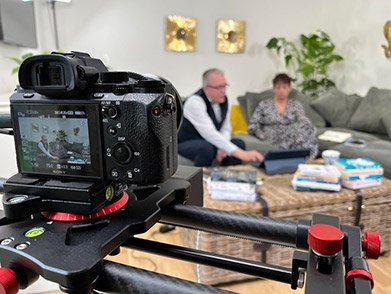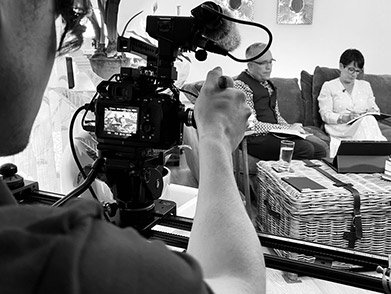A comprehensive guide to e-learning video production
Introducing e-learning video production
In our digital world, e-learning has become an increasingly popular method for individuals and brands to nurture and share new skills and knowledge. Video production plays a crucial role in creating effective e-learning programmes. Programmes that actually make a difference!
In this comprehensive guide, we will cover everything you need to know about e-learning video production, including its benefits, processes, and best practices.
Benefits of e-learning video production
The benefits and subsequent impact of including video content in your e-learning programmes are plentiful. Here are some of the key reasons you should be adding video content to your e-learning programmes:
Firstly, high-quality videos provide an engagingly rich and interactive learning experience, which is crucial for understanding and retaining information.
Second, video content allows learners to consume information at their own pace and convenience.
Third, videos enable you to reach a global audience, regardless of location and time zone. And with the addition of caption translations, you can easily reach an even larger global audience.
Lastly, videos are a cost-effective solution for creating a volume of bespoke, evergreen premium e-learning content.
Process of e-learning video production
The process of e-learning video production involves several stages; from careful pre-production through to stylish production, and creative post-production.
Pre-Production:
In the pre-production stage, you need to identify your target audience, learning objectives, and content format. This stage can involve scriptwriting, storyboarding, and planning any supplementary visuals such as cutaway footage, stock or animation as necessary.
Where particularly complex, lengthily or technical information needs presenting to camera, the best approach is to script and record with autocue. When you work with Majestical your project manager (PM) will work carefully with you to make sure your e-learning videos are planned and prepared to most effectively deliver the results you’re looking for.
Production:
In the production stage, your e-learning content is created. Whether that requires a location shoot, studio setup or whether you need a library of visual resources designing. At the end of this stage all your visual and audio resources are ready for post-production.
Effective video production requires a team of experienced creative professionals, which could include:
Producer
Director
Camera operator
Sound engineer
Presenters/actors
Voice over artists
Graphic designers
Post-Production:
In the post-production stage, your videos will be edited, colour graded, animated, voiced and audio mixed to a premium quality finish. Any interactive elements such as quizzes and assessments will be considered at this stage as well.
When post-production is complete your videos are ready for publishing. Remember to include an eye-catching, branded thumbnail and all necessary captions for each e-learning video you publish. Read on for more best practices.
Best practices for e-learning video production
To create effective e-learning videos, we recommend these best practices:
Keep it concise and engaging: Learners have a short attention span, so keep your video content messaging clear and relevant to retain their attention.
Use visuals and graphics: Visuals and graphics help learners to understand complex concepts and retain information. They also reinforce your brand.
Incorporate interactive elements: Incorporate interactive elements that complement the videos on your learning platform such as quizzes, assessments, and simulations. These elements enhance learner engagement and retention.
Use high-quality kit: The equipment you use to create your eLearning video content reflects the perceived value of your brand. Using high-quality equipment such as cameras, microphones, and lighting creates the highest possible quality video content and gives viewers the best possible impression of your brand value proposition.
Provide closed captions: Providing closed captions helps learners with hearing impairments and those who prefer to read along.
Include thumbnails: Thumbnails give your learners an immediate understanding of the course video content. They also serve to encourage views; crucial to your learner's success.
Majestical method for e-learning video success
At Majestical we take a careful and considered approach to all e-learning video production projects. And we’re serious about the impact of your video content.
Here are the steps we take to creating successful e-learning video content for every client →
Identify your target audience
Define your learning objectives
Choose the most appropriate content format
Scriptwriting and/or storyboarding as necessary
Plan and shoot content
Build necessary graphic elements
Edit content
Build and apply motion graphics
Record and apply audio elements (voice over, music etc)
Create and apply closed captions
Review and approve content
Render and publish
E-learning video success
Read our case study, which shares the global, award-winning success achieved by one of our e-learning video production projects.
Creating your e-learning video content
E-learning video production is an essential component of creating effective e-learning programmes. By following the best practices and processes outlined in our comprehensive guide, you will create high-quality videos that engage and educate your learners.
At Majestical, we specialise in creating e-learning video content that outranks the competition. And we make sure you enjoy the process too!
Do you want to add effective e-learning video content to your learning programmes too?
Click on the button below and see how we can help you maximise the performance of your e-learning programmes!
And if you liked this blog then please share it with your Learning & Development contacts and tell them to follow @itsmajestical to be kept up to date with more ambitious video production and animation success.








E-learning video content can take various forms to effectively engage and educate learners. In this article we share five of the best types of e-learning video content that will help you to deliver the best learning outcomes.